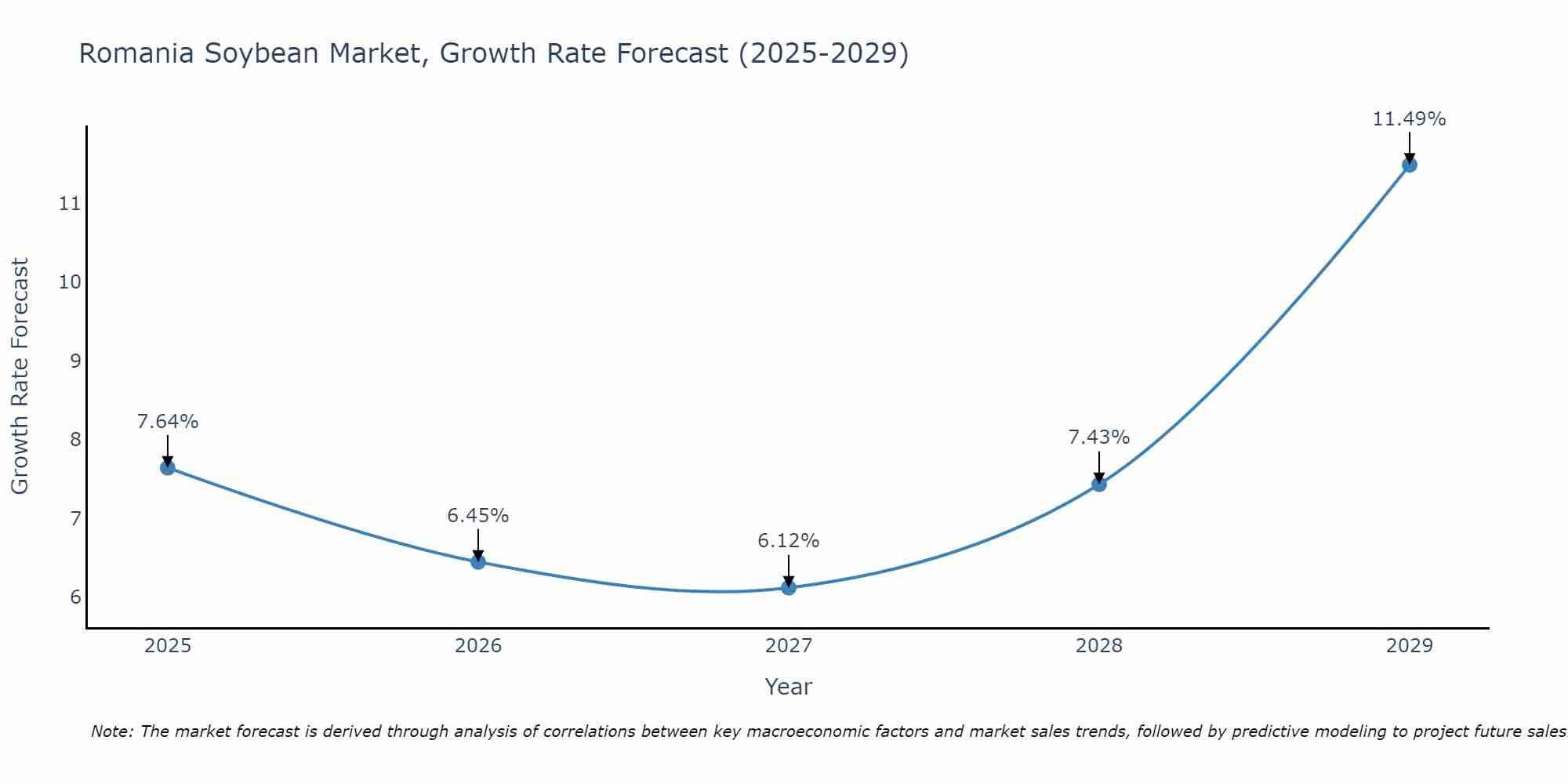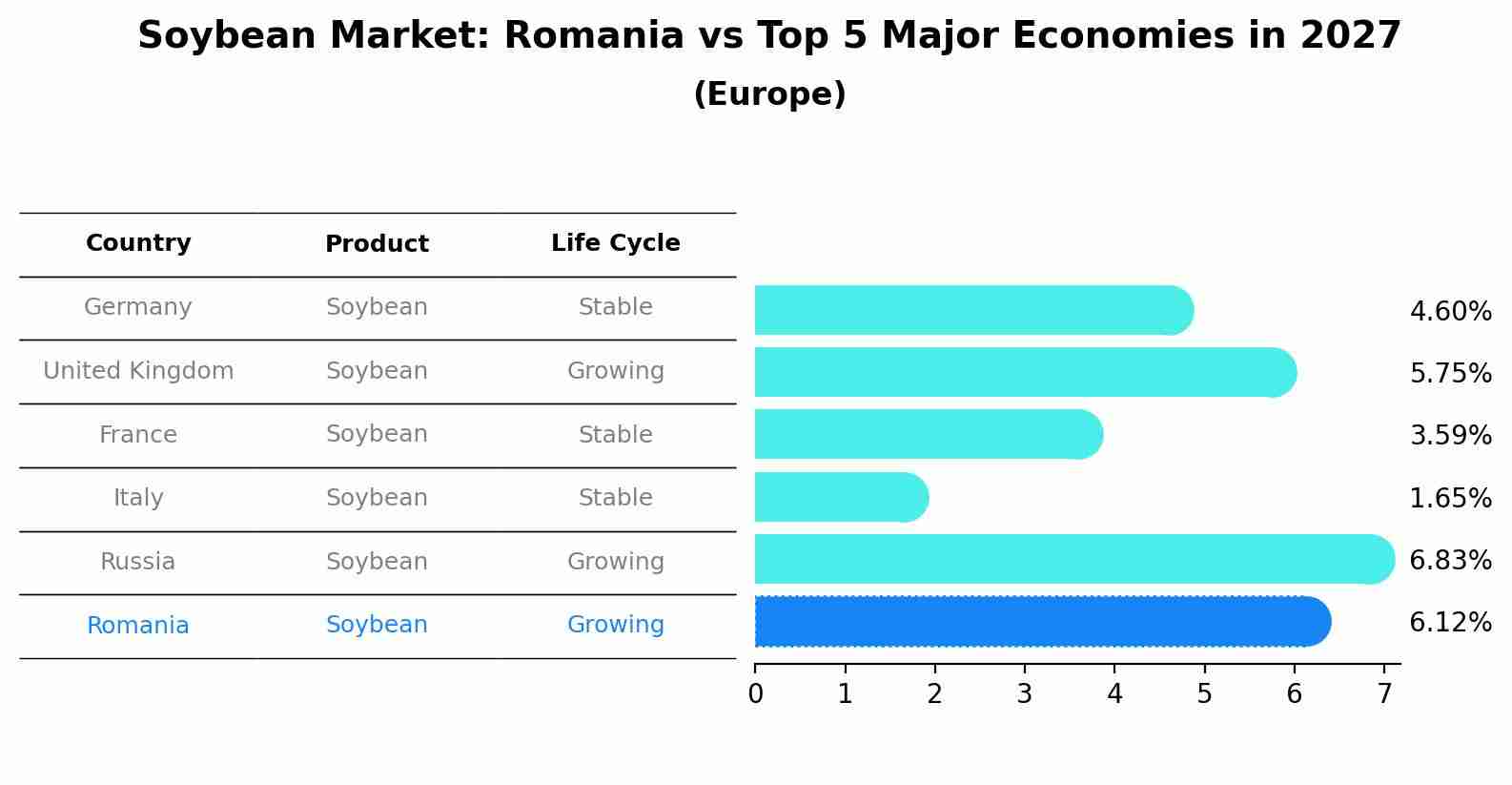Romania Soybean Market Outlook | Value, Industry, Companies, Analysis, Forecast, Growth, Share, Size, COVID-19 IMPACT, Trends & Revenue
| Product Code: ETC224658 | Publication Date: Aug 2022 | Updated Date: Aug 2025 | Product Type: Market Research Report | |
| Publisher: 6Wresearch | Author: Sumit Sagar | No. of Pages: 75 | No. of Figures: 35 | No. of Tables: 20 |
Romania Soybean Market Size Growth Rate
The Romania Soybean Market is projected to witness mixed growth rate patterns during 2025 to 2029. Commencing at 7.64% in 2025, growth builds up to 11.49% by 2029.

Soybean Market: Romania vs Top 5 Major Economies in 2027 (Europe)
In the Europe region, the Soybean market in Romania is projected to expand at a growing growth rate of 6.12% by 2027. The largest economy is Germany, followed by United Kingdom, France, Italy and Russia.

Romania Soybean Market Overview
The Romania soybean market is experiencing steady growth due to increasing demand from various sectors, including animal feed production, food processing, and biofuel industries. The country`s favorable climate and agricultural practices make it conducive for soybean cultivation, with a significant portion of the crop being used domestically. Romania also exports soybeans to other European countries, contributing to its position as a key player in the regional soybean market. Government support for soybean production, coupled with advancements in technology and farming techniques, is expected to further boost the market in the coming years. Overall, the Romania soybean market presents promising opportunities for both domestic producers and international traders looking to capitalize on the growing demand for soybeans.
Romania Soybean Market Trends
Currently, the Romania soybean market is experiencing growth driven by increasing demand for soybean products in various industries such as food processing, animal feed, and biofuels. The country`s favorable climate conditions for soybean cultivation have led to an expansion in soybean production, making Romania one of the key players in the European soybean market. Additionally, the rising awareness among consumers about the health benefits of soy products has further boosted the demand for soybeans in the country. However, challenges such as fluctuating global market prices, competition from other oilseed crops, and sustainability concerns related to soybean production practices are also influencing the market dynamics. Overall, the Romania soybean market is poised for continued growth, driven by both domestic demand and export opportunities.
Romania Soybean Market Challenges
In the Romania Soybean Market, some challenges include limited domestic production capacity, reliance on imports, fluctuating global prices, and competition from other oilseed crops. The country`s soybean production is not sufficient to meet the growing demand from the livestock industry, leading to a heavy dependence on imports. This reliance makes the market vulnerable to price volatility and currency fluctuations. Additionally, Romania competes with other oilseed crops such as sunflower and rapeseed, which can impact soybean cultivation and market share. Farmers may face difficulties in accessing quality seeds, modern technology, and sufficient financing to improve yields and competitiveness in the global market. Overall, these challenges pose barriers to the growth and sustainability of the Romania Soybean Market.
Romania Soybean Market Investment Opportunities
Investment opportunities in the Romania Soybean Market are promising due to the increasing demand for soybeans in various industries such as food processing, animal feed, and biofuel production. Romania has favorable agricultural conditions for soybean cultivation, with fertile soil and adequate climate. Investors can consider opportunities in soybean farming, processing facilities, and export businesses. The Romanian government is also implementing policies to support agricultural development, offering incentives and subsidies to encourage investment in the sector. Additionally, with Romania`s strategic location in Europe, there is potential for exporting soybeans to other European countries, further expanding market opportunities. Overall, the Romania Soybean Market presents attractive investment prospects for those interested in the agricultural sector and seeking to capitalize on the growing demand for soybeans.
Romania Soybean Market Government Policy
The Romanian government has implemented policies to support the soybean market, including subsidies and incentives for soybean production. The government provides financial aid to soybean farmers to encourage domestic production and reduce reliance on imports. Additionally, there are regulations in place to ensure the quality and safety of soybean products, as well as to promote sustainable farming practices. The government also supports research and development in the soybean sector to enhance productivity and competitiveness. Overall, these policies aim to strengthen the soybean market in Romania, boost domestic production, and ensure food security for the country.
Romania Soybean Market Future Outlook
The future outlook for the Romania Soybean Market appears positive due to increasing demand for soybean products in various industries such as food, feed, and biofuels. With a growing population and a shift towards healthier diets, there is a rising consumption of soy-based products in Romania. Additionally, the government`s support for soybean cultivation through subsidies and incentives is expected to boost domestic production, reducing the country`s reliance on imports. However, challenges such as climate change impacting agricultural yields and competition from other crops may pose risks to the market. Overall, the Romania Soybean Market is likely to witness steady growth in the coming years driven by changing consumer preferences and government initiatives supporting the agricultural sector.
Key Highlights of the Report:
- Romania Soybean Market Outlook
- Market Size of Romania Soybean Market, 2021
- Forecast of Romania Soybean Market, 2031
- Historical Data and Forecast of Romania Soybean Revenues & Volume for the Period 2018 - 2031
- Romania Soybean Market Trend Evolution
- Romania Soybean Market Drivers and Challenges
- Romania Soybean Price Trends
- Romania Soybean Porter's Five Forces
- Romania Soybean Industry Life Cycle
- Historical Data and Forecast of Romania Soybean Market Revenues & Volume By Applications for the Period 2018 - 2031
- Historical Data and Forecast of Romania Soybean Market Revenues & Volume By Crush for the Period 2018 - 2031
- Historical Data and Forecast of Romania Soybean Market Revenues & Volume By Feed Use for the Period 2018 - 2031
- Historical Data and Forecast of Romania Soybean Market Revenues & Volume By Food Use for the Period 2018 - 2031
- Romania Soybean Import Export Trade Statistics
- Market Opportunity Assessment By Applications
- Romania Soybean Top Companies Market Share
- Romania Soybean Competitive Benchmarking By Technical and Operational Parameters
- Romania Soybean Company Profiles
- Romania Soybean Key Strategic Recommendations
Frequently Asked Questions About the Market Study (FAQs):
1 Executive Summary |
2 Introduction |
2.1 Key Highlights of the Report |
2.2 Report Description |
2.3 Market Scope & Segmentation |
2.4 Research Methodology |
2.5 Assumptions |
3 Romania Soybean Market Overview |
3.1 Romania Country Macro Economic Indicators |
3.2 Romania Soybean Market Revenues & Volume, 2021 & 2031F |
3.3 Romania Soybean Market - Industry Life Cycle |
3.4 Romania Soybean Market - Porter's Five Forces |
3.5 Romania Soybean Market Revenues & Volume Share, By Applications, 2021 & 2031F |
4 Romania Soybean Market Dynamics |
4.1 Impact Analysis |
4.2 Market Drivers |
4.2.1 Increasing consumer awareness about the health benefits of soybeans |
4.2.2 Growing demand for plant-based protein sources |
4.2.3 Government initiatives promoting soybean cultivation in Romania |
4.3 Market Restraints |
4.3.1 Fluctuating prices of soybeans in the global market |
4.3.2 Weather variability impacting soybean production in Romania |
5 Romania Soybean Market Trends |
6 Romania Soybean Market, By Types |
6.1 Romania Soybean Market, By Applications |
6.1.1 Overview and Analysis |
6.1.2 Romania Soybean Market Revenues & Volume, By Applications, 2021-2031F |
6.1.3 Romania Soybean Market Revenues & Volume, By Crush, 2021-2031F |
6.1.4 Romania Soybean Market Revenues & Volume, By Feed Use, 2021-2031F |
6.1.5 Romania Soybean Market Revenues & Volume, By Food Use, 2021-2031F |
7 Romania Soybean Market Import-Export Trade Statistics |
7.1 Romania Soybean Market Export to Major Countries |
7.2 Romania Soybean Market Imports from Major Countries |
8 Romania Soybean Market Key Performance Indicators |
8.1 Average yield per hectare of soybeans in Romania |
8.2 Percentage of agricultural land in Romania allocated to soybean cultivation |
8.3 Adoption rate of new soybean farming technologies in Romania |
9 Romania Soybean Market - Opportunity Assessment |
9.1 Romania Soybean Market Opportunity Assessment, By Applications, 2021 & 2031F |
10 Romania Soybean Market - Competitive Landscape |
10.1 Romania Soybean Market Revenue Share, By Companies, 2021 |
10.2 Romania Soybean Market Competitive Benchmarking, By Operating and Technical Parameters |
11 Company Profiles |
12 Recommendations |
13 Disclaimer |
- Single User License$ 1,995
- Department License$ 2,400
- Site License$ 3,120
- Global License$ 3,795
Search
Thought Leadership and Analyst Meet
Our Clients
Related Reports
- Afghanistan Apparel Market (2026-2032) | Growth, Outlook, Industry, Segmentation, Forecast, Size, Companies, Trends, Value, Share, Analysis & Revenue
- Canada Oil and Gas Market (2026-2032) | Share, Segmentation, Value, Industry, Trends, Forecast, Analysis, Size & Revenue, Growth, Competitive Landscape, Outlook, Companies
- Germany Breakfast Food Market (2026-2032) | Industry, Share, Growth, Size, Companies, Value, Analysis, Revenue, Trends, Forecast & Outlook
- Australia Briquette Market (2025-2031) | Growth, Size, Revenue, Forecast, Analysis, Trends, Value, Share, Industry & Companies
- Vietnam System Integrator Market (2025-2031) | Size, Companies, Analysis, Industry, Value, Forecast, Growth, Trends, Revenue & Share
- ASEAN and Thailand Brain Health Supplements Market (2025-2031) | Strategy, Consumer Insights, Analysis, Investment Trends, Opportunities, Growth, Size, Share, Industry, Revenue, Segments, Value, Segmentation, Supply, Forecast, Restraints, Outlook, Competition, Drivers, Trends, Demand, Pricing Analysis, Competitive, Strategic Insights, Companies, Challenges
- ASEAN Bearings Market (2025-2031) | Strategy, Consumer Insights, Analysis, Investment Trends, Opportunities, Growth, Size, Share, Industry, Revenue, Segments, Value, Segmentation, Supply, Forecast, Restraints, Outlook, Competition, Drivers, Trends, Demand, Pricing Analysis, Competitive, Strategic Insights, Companies, Challenges
- Europe Flooring Market (2025-2031) | Outlook, Share, Industry, Trends, Forecast, Companies, Revenue, Size, Analysis, Growth & Value
- Saudi Arabia Manlift Market (2025-2031) | Outlook, Size, Growth, Trends, Companies, Industry, Revenue, Value, Share, Forecast & Analysis
- Uganda Excavator, Crane, and Wheel Loaders Market (2025-2031) | Strategy, Consumer Insights, Analysis, Investment Trends, Opportunities, Growth, Size, Share, Industry, Revenue, Segments, Value, Segmentation, Supply, Forecast, Restraints, Outlook, Competition, Drivers, Trends, Demand, Pricing Analysis, Competitive, Strategic Insights, Companies, Challenges
Industry Events and Analyst Meet
Whitepaper
- Middle East & Africa Commercial Security Market Click here to view more.
- Middle East & Africa Fire Safety Systems & Equipment Market Click here to view more.
- GCC Drone Market Click here to view more.
- Middle East Lighting Fixture Market Click here to view more.
- GCC Physical & Perimeter Security Market Click here to view more.
6WResearch In News
- Doha a strategic location for EV manufacturing hub: IPA Qatar
- Demand for luxury TVs surging in the GCC, says Samsung
- Empowering Growth: The Thriving Journey of Bangladesh’s Cable Industry
- Demand for luxury TVs surging in the GCC, says Samsung
- Video call with a traditional healer? Once unthinkable, it’s now common in South Africa
- Intelligent Buildings To Smooth GCC’s Path To Net Zero


















